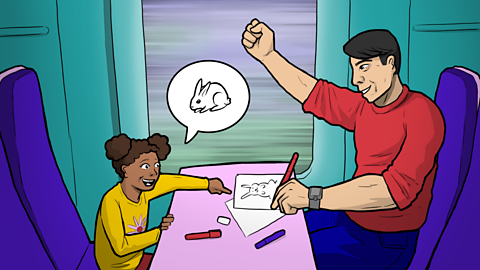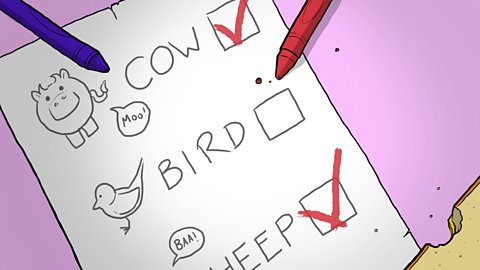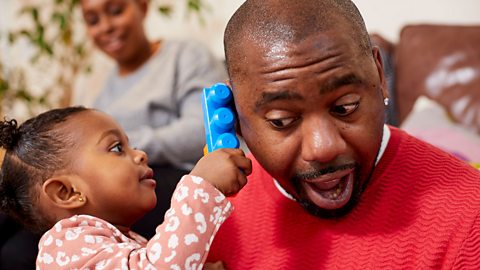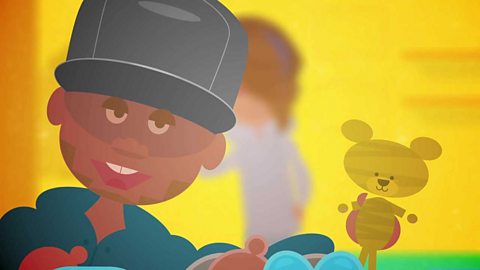Whether you're going to visit relatives, or getting away for a well-deserved break, chances are you'll have to experience some big journeys with your little ones at some point.
And while it might be understandable to reach for devices like tablets while confined in a car, train or coach, think of it as time to communicate and bond with your child. Instead of screen time, itâs great to spend the journey chatting and playing games - and it will help pass the time too, says speech and language therapist Janet Cooper.
âAt home, normally youâd be washing up, cleaning, putting things away. On a long journey youâre kind of forced to be together, so why not turn that into time thatâs really positive and helps your childâs learning?"
Simple activities are the best â the most youâll need to grab for your next road trip is some paper and pens.
âThe other thing is that, depending on where youâre heading, youâre going to see lots of different things, so thereâs an opportunity to use new vocabulary," explains Janet. "Whether you travel through countryside or built-up areas â and these are all chances to bring in new words.â

Travelling with a baby
Babies love faces and yours is an asset on a long journey. Using it to make sounds and pull silly expressions a great way to keep your little one entertained.
âYou could copy one another. If baby makes a sound, then you copy, and then you make a sound and see if baby can copy,â adds Janet. âPeekaboo is another great one and is perfect if youâre travelling in the front seat and baby is on the back seat.â
Try anticipation activities too, adds Janet. âDepending on the babyâs position, you could talk about things as they pass. For example, âHere comes a lorry, itâs coming, itâs coming⊠and hereâs the lorry!â as it passes. Itâs fun, exciting and gives you lots of conversational opportunities.â
Singing nursery rhymes is also a great activity (depending on the tolerance of the driver and your fellow passengers!). âSinging is great for all ages, whether thatâs putting some music on in your car stereo, or just singing rhymes and doing the actions with one another.â

Travelling with toddlers
Again, singing is a great option. âWith older children, you could let them take the lead and choose what to sing. They could start a rhyme and see if others can finish it,â says Janet.
Youâre less likely to be singing on public transport, but you could try some more creative activities.
On a bus or train, youâll be alongside or opposite one another, so paper and pens are a great thing to take.
âDraw a picture in stages and see if your child can guess what it is. Do an outline, ask them if they can guess, then add more detail and ask them again,â explains Janet. âYou could do this in the car too (provided youâre not the driver!) and hold it up.â
âMy other favourite, for an older child who has pen control, is drawing a squiggle and encouraging them to turn it into a picture and talk about what theyâve drawn. When theyâve finished, they could draw you a squiggle and you can turn it into a picture too. You could also try this activity in a car â itâs something that an older child could do in a back seat with their younger sibling.â
It's important to be close, face-to-face and making eye contact, adds Janet. âAlso using your hands to gesture will help babies and children understand you. You could try some pointing or clapping games or âguess the gestureâ â encourage your child to guess what you are signing.â
Or how about a game of bingo? âBefore you leave home, make a simple card with pictures of things to spot on the journey like a red car or a cow. Or if your child is older, create a written list with their input,â explains Janet. âTell your child what to spot next or let them choose if theyâre able to.â

A simpler version of this would be to choose a new object to spot every 10 minutes. âEncourage your child to make noises when they see each thing. For example, if you see a car make a âbroom, broomâ noise or a âbaa, baaâ noise for a sheep. Then you could change the object to spot every 10 minutes. This breaks up the journey well. By the time youâve done it twice, 20-30 minutes of the journey have passed. This means your children are less likely to get bored as youâre changing the game quite regularly.â
Other great options for older children are memory games, which are great for boosting their language skills, says Janet. âYou could try âI went to the shops and boughtâŠâ making up a list of items for them to remember, adding items over and over. For toddlers, you might be able to get up to three or four items.â
And last but not least. Thereâs always the classic I Spy to fall back on. âI Spy is great for children 2 years plus. You can simplify or make it harder depending on their age. Using descriptive language like âIâve picked something thatâs greenâ will make it easier. For older children, to make it harder, you could ask them to say what sound it begins with or what it rhymes with. Itâs great for their imagination and their memory skills too.â
Bon voyage!
Child car seats are the safest option for car travel but must be suitable for your child's weight and size and also be correctly fitted. For tips and advice visit , which also has guidance on using .






